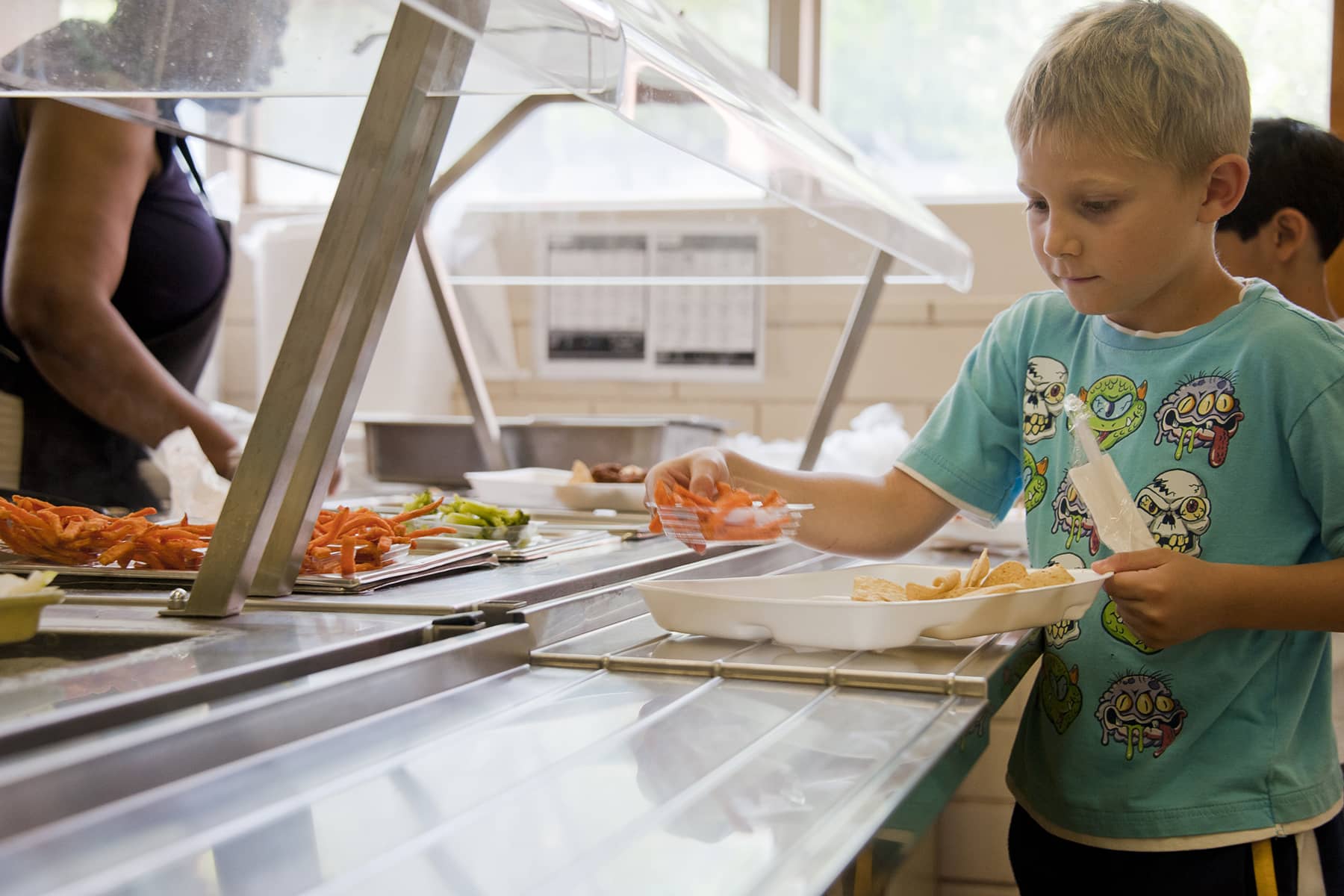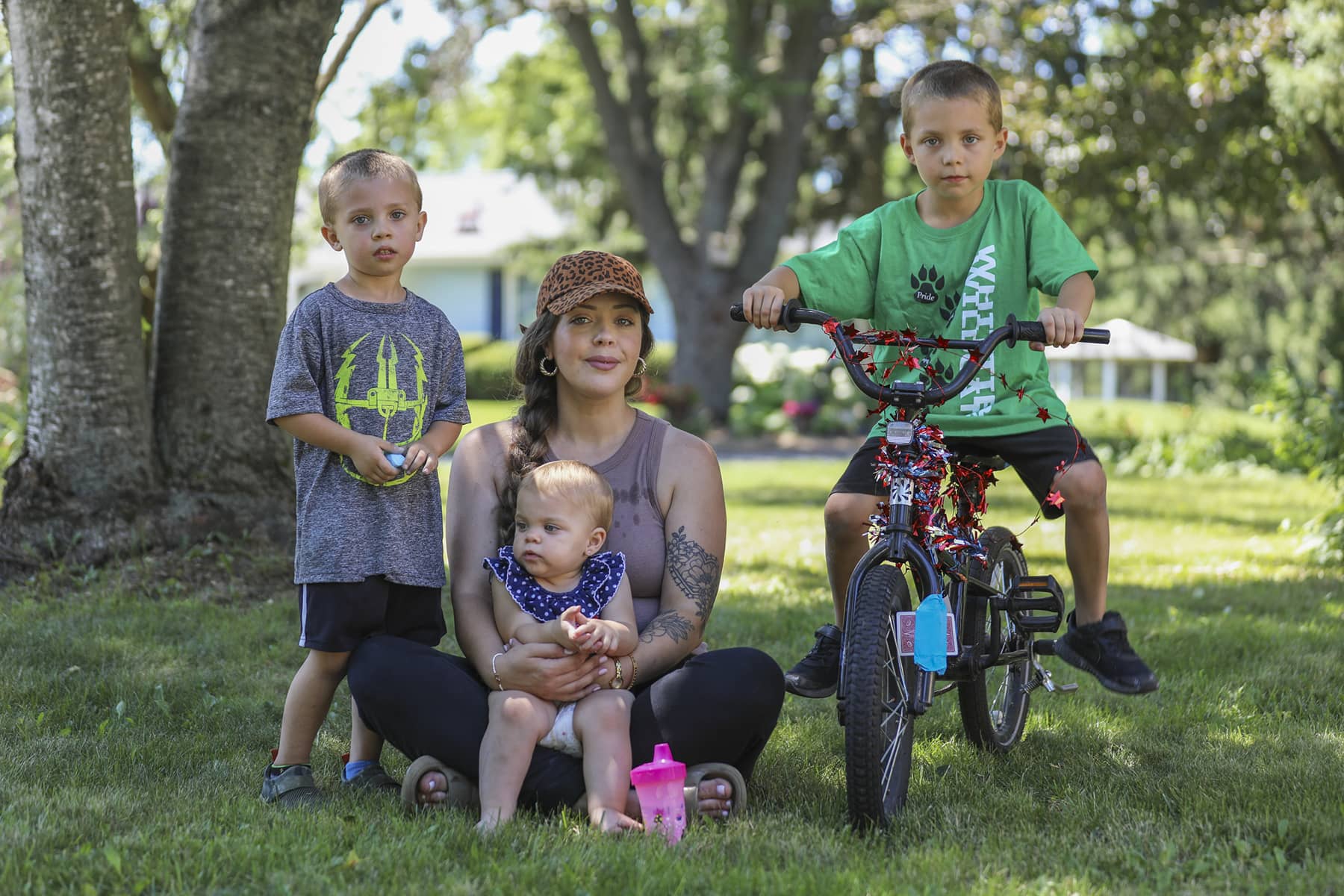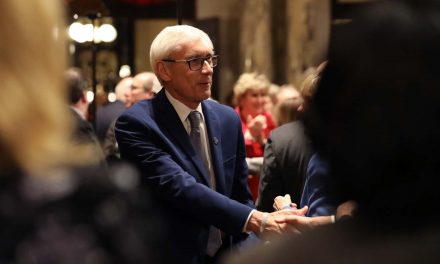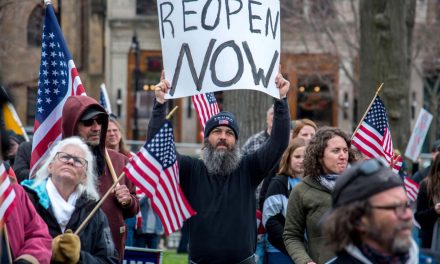
The COVID-19 pandemic forced students to pack up their bags and switch from whiteboards to laptops. Empty schools meant empty cafeterias.
Until the pandemic, Jana Goodman, a mother of three and longtime resident of Waukesha, Wisconsin, never used free school lunches. Even though she said her family was always “one broken down car away from a disaster,” her only school-age child at the time, Jacob, did not qualify for free and reduced meals.
Then the pandemic sent the Goodmans’ finances into a tailspin. After 15 years in the medical field as an administrative employee, she was furloughed for most of the summer in 2020. Her husband, who works three jobs, saw income from his most profitable gig as a DJ plummet as people stayed home. To hold onto their house and to build a strong financial base for their children’s future, the Goodmans used any assistance they could to stay afloat.
“The free meals was a huge one, because it may not seem like it day to day, but lunch money adds up,” Goodman said, adding that the family continued picking up the meals through the summer of 2021.
Roughly 1 in 5 children face food insecurity in Wisconsin. For families like the Goodmans already struggling to pay their bills before the pandemic, the situation quickly became dire.
Schools quickly pivoted to fill the gap thanks to federal waivers that allowed districts to run more flexible food service programs. One key waiver permitted schools to opt into federal programs normally restricted by income-based eligibility, allowing them to serve free meals to all students.
The Seamless Summer Option, along with similar federal programs, gave schools, even those meeting virtually, the ability to provide free meals for all students during the pandemic.
What started out as an emergency relief provision has since turned into a nationwide experiment — one testing the benefits and costs of offering universal free meals to an unprecedented number of U.S. students, regardless of family income.
In recent months, universal free meals have garnered approval from schools, anti-hunger advocates and legislators across Wisconsin who argue that breakfast and lunch — like textbooks — should be available at no cost to any K-12 student.
But the federal waiver that permitted universal free school meals expired June 30, and legislation to extend or permanently implement a free meals program has stalled at the state and federal level, leaving an uncertain future for free school meals in Wisconsin.
And some elected officials here strongly object to the idea. The School District of Waukesha, where Goodman’s son attends school, became the epicenter of that debate nationally, when for a brief time it was the only district in Wisconsin to reject free meals for all.
“I had gotten used to the free meals. I thought it was going to continue,” Goodman said. “So that meant looking at our monthly income, and looking at what we’re spending on groceries. … It meant going back to a place where I swiped my card and I’d have to check my account to see if I could afford the food I wanted to buy.”
Universal school meals
In 2019, 39% of children qualified for free or reduced lunch across the 424 Wisconsin school districts participating in U.S. Department of Agriculture’s child nutrition programs, according to the state Department of Public Instruction. The abrupt halt to school lunches during the pandemic was a blow to many of these families who relied on those meals.
The University of Wisconsin-Madison’s Judi Bartfeld said the number of food insecure children across the country grew during the first year of the pandemic.
“While Wisconsin households overall generally report less food insecurity than the country as a whole, this isn’t true for kids — they are more likely to live in food insecure households than kids nationwide,” said Bartfeld, coordinator of the Wisconsin Food Security Project. “School meals are obviously just one piece of the puzzle — but they are clearly an area in which more can be done.”
In the 2020-21 academic year, Karrie Isaacson, the school nutrition assistant director for the state Department of Public Instruction, said Wisconsin school districts could choose from three programs — the Seamless Summer Option, the Summer Food Service Program or the National School Lunch Program.
The two summer programs allowed schools to provide meals for free year-round to students and receive reimbursements for each meal, while the National School Lunch Program operated with the traditional free and reduced meals qualifications based on income eligibility.
For the 2021-22 school year, Isaacson said every school in the state — except briefly, Waukesha — chose to offer universal free meals through the Seamless Summer Option. The only exceptions were low-income schools and other childcare institutions already providing free meals through other federal programs such as the Community Eligibility Provision (CEP).
Bartfeld said universal free meals help food insecure or otherwise financially struggling families because they do not have to specially qualify or fill out paperwork. The result is more children eating at school, kids being less likely to skip breakfast and some improvement in school attendance, she said.
Fewer administrative hoops
Following the expansion of free meals during the pandemic, DPI nutrition consultant Kirsten Homstad said schools cited a decrease in administrative burdens since they did not have to keep track of students’ free or reduced status.
“It frees up their (schools’) own resources from having to be gatekeepers and lets them just feed the kids and really treat food just like anything else that you get as part of the school day,” Bartfeld said.
It also addressed the issue of unpaid lunch funds. About three-quarters of the school districts in the national School Nutrition Association 2019 report said they had unpaid student meal debt.
“It’s sped up some of the meal service and allowed them (schools) to focus some time more on other things,” Homstad said. “It streamlined some of the flow, and then they don’t have to be concerned, either, with certifying students for the meal program.”
Free meals also help reduce “lunch shaming.” One example is alternative cheaper meals, like cheese sandwiches, that students are sometimes given when the money in their school meal account runs out.
Isaacson said free meals boosted participation across Wisconsin, particularly in school breakfast programs, which is a feat, considering Wisconsin notoriously ranks as one of the lowest states in the country for participation in breakfast programs.
After getting a trial run during the pandemic, Isaacson said there is broad support in Wisconsin schools to continue free meals for all. UW-Madison historian Andrew Ruis said this isn’t surprising.
“Significant emergencies like the Great Depression (and) the COVID-19 pandemic often change people’s views about what is possible from a social or political standpoint,” Ruis said. “I think there’s a real chance that universal school meals will be realized on a broader scale than they currently are.”
Support grows for free meals
But Isaacson said funding is the main barrier to a permanent free meals program. For all food service programs, federal funds only reimburse the cost of meals served to students eligible for free meals. This means schools must pay for the costs, such as labor and food, above the provided federal assistance, which Bartfeld said can make it difficult for schools to take advantage of federal programs, even free meal programs like CEP.
Wisconsin’s proposed Healthy School Meals for All Act seeks to fill in the gap by providing additional state funds to reimburse schools that offer free meals to all students. Assembly Bill 805 was introduced in the Wisconsin Legislature in January, co-authored by Rep. Kristina Shelton, D-Green Bay, Rep. Francesca Hong, D-Madison, and 28 other Assembly Democrats.
After the pandemic, Hong said, free meals seemed like a “no brainer.”
The bill also incentivizes schools, public and private, to participate in both the federal breakfast and lunch programs in exchange for guaranteed full reimbursement for all free meals served.
National school meal program expert Jennifer Gaddis, who collaborated on aspects of the legislation, said higher participation rates could drive down costs for schools.
“(Higher participation in school meals) brings more revenue into school nutrition programs and lowers the per meal cost of production,” Gaddis said. “When you have a much higher rate of participation, that tends to make more money available to invest in things like sourcing higher quality ingredients, doing more Farm to School or paying your workers better.”
Still, the total cost of the bill is uncertain, according to a fiscal estimate from the DPI.
The legislation already has a statewide campaign called Healthy School for All Wisconsin. The bill has garnered support from Feeding America, the Wisconsin Farmers Union, the Wisconsin Council of Churches and more than 50 other organizations across the state, including school districts in the Fox Cities, Pulaski and the Tri-County Area School District in Plainfield.
While the measure did not make it out of committee this session, Hong said the bill’s journey is far from over. The same could be said about the larger debate over whether to provide free meals for all students regardless of income.
Waukesha’s battle over free meals
Waukesha’s school district was the only one in Wisconsin to opt out of the Seamless Summer Option for the 2021-22 school year. Initially, the Board of Education voted 9-0 to revert to the National School Lunch Program, which provides free and reduced lunch to students based on income eligibility guidelines.
The Waukesha Food Pantry and other organizations pressured the school board to change its vote. The Alliance for Education in Waukesha led the charge, drafting press releases, hosting rallies and generating local and national media attention, which prompted threats against some board members and spurred media inquiries from Moscow.
Dave Dringenburg, a member of the Alliance and a father of two daughters in the district, said the board’s decision was out of touch with the community, where nearly one-third of the district’s 11,766 students qualified for free or reduced lunch in 2019.
During the 2020-21 school year, Goodman felt her family could get the free meals without judgment or embarrassment. All the support she felt vanished when she learned about the school board’s vote from a Washington Post article that led Waukesha to trend on Twitter.
After the board’s decision hit the national news, former member Greg Deets said he received at least 500 emails from around the world. Deet’s original rationale behind opting out of free meals was the dropping COVID-19 case numbers and the ability to to return to the free meals program if need be. Other members agreed.
But what he learned in the emails changed his mind and reversed his vote. A narrow majority of the board came to the same conclusion, voting 5-4 on August 30, 2021 to keep the free meal program through the 2021-22 school year.
Several board members, however, made it clear they do not support free meals for all.
At the meeting where the decision was reversed, school board member Kelly Piacsek said the SSO was “wasteful by design,” noting students who don’t need the program can’t pay for meals even if they want to. Piacsek said giving “ultimate authority” to the federal government to feed all students regardless of need is “game over” for local school boards. She likened the issue to the ongoing national controversy over how or whether to teach young children about race and privilege.
Anthony Zenobia, another member who voted against SSO, said implementing free meals as a “blanket decision” would degrade the district along with the other “progressive thinking that has wrought destruction” on schools.
“I believe it was important to make sure all children are fed,” said school board member Joseph Como, who voted in favor of the SSO option at the followup meeting. “I also believe that this program should not exist forever, and this board needs to make sure it does not continue forever.”
Even after the board’s vote, the district’s administration declined to use the money to pay for free breakfasts at eight schools for six months, which Deets said cost the district an estimated $325,000 in federal reimbursement money.
Dringenburg, whose daughters go to a school where breakfast wasn’t served, said feeding kids should be apolitical – yet some board members ignored what he believed most of the community wanted in favor of partisan arguments.
Said Dringenburg: “There’s no real reason why it needed to become what it was.”
Future murky for school food service
As the June 30 expiration date approached, Congress passed a bipartisan bill, called the Keep Kids Fed Act, which temporarily increases school meal reimbursements and other pandemic-related nutrition waivers.
But it rejected the USDA’s recommendation to extend the free meals waiver for another year — meaning free and reduced meals will again be subject to family income eligibility requirements in the upcoming 2022-23 school year.
Still, Ruis believes there is potential for “significant bipartisan action” at the state level, which could build momentum in the free meals movement. States including Maine and California have already passed legislation to ensure free meals for all students in their state budgets.
Bartfeld isn’t so hopeful here in Wisconsin.
“I don’t know that it (free meals) is going to gain traction as a policy simply because things are very polarized in the state in terms of the kind of changes that would have to happen,” she said.
Deets may be proof of that. He lost his school board seat in the April election along with two other incumbents to three Republican-backed candidates in the officially nonpartisan race. Deets said he thinks school meals were a “piece” of the reason he was ousted.
For now, Goodman is preparing to face a school year without free meals for her two children now in school. The family finances have still not bounced back from the pandemic, and with food prices rising, she is bracing for a “scary time.”
“It’s like a domino effect that impacts everything else,” Goodman said. “What are we going to hold off on to pay for food for the school year? What are we not going to buy that we need that’s going to have to get put on hold … because we don’t have the money to pay for food? Those are the decisions we are making every week in my house.”
Erin Gretzinger and Maddie Bergstrom
Coburn Dukehart
Originally published by wisconsinwatch.org
The nonprofit Wisconsin Center for Investigative Journalism collaborates with Wisconsin Public Radio, Wisconsin Public Television, other news media and the UW-Madison School of Journalism and Mass Communication. All works created, published, posted or disseminated by the Center do not necessarily reflect the views or opinions of UW-Madison or any of its affiliates.















